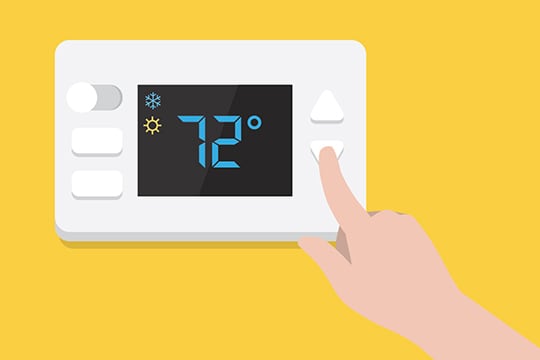-
Repair or Replace? Learn the Signs of a Bad Thermostat and How to Respond
-
If your forced-air system (HVAC unit) isn’t producing air or heat, the first thing you should do is check your home thermostat. How do you test your thermostat? What are some signs that you have a bad home thermostat? And how do you know what kind of thermostat is right for you? Read on for some answers to common questions.
How to test a home thermostat
Is the temperature in your home suddenly too hot or too cold? Before you place a call to repair your HVAC system, make sure the fix isn’t an easy tweak to your thermostat. Some quick tests include:
- Switch the mode, if needed. Is your thermostat set correctly to heat or cool mode? Do you want it to be on auto or fan mode? A quick flip of a switch may be all that’s needed.
- Check your thermostat’s location in the house. A thermostat in direct sunlight or near drafty windows and doors can affect its performance and efficiency.1
- Check the batteries. If your thermostat runs on batteries, it might be time to change them.2
- Make sure the settings are correct. If you have a programmable thermostat, be sure it’s set to turn on and off at the programmed temperatures.2
Still having home thermostat problems? The issue could be in the wiring, which would require some handiwork to check for loose, cut or corroded wires on the base of your thermostat. If you don’t know how to do this or you need more guidance to determine if your home thermostat is bad, call a professional for help.
-
Home thermostat buying guide
When it’s time to buy a new home thermostat, here are some options for you to consider.
-
Manual (or non-programmable) thermostat: Like the name suggests, you control the temperature by setting it manually. You may want to use this type of home thermostat if you’re home often and prefer a fixed temperature.
Programmable thermostat: With this home thermostat, you can let the system know to change your home’s temperature during different times of the day and night. According to the U.S. Department of Energy, if you turn your thermostat down 7° to 10°F from its normal setting for eight hours a day, you can save up to 10% a year on heating and cooling costs.1 By setting the temperature cooler while you sleep, for example, you could save a good chunk of money on your monthly bill.
Smart thermostat: These home thermostats learn your lifestyle as you use them, automatically adjusting to your schedule. You can connect the thermostat to your home’s Wi-Fi and operate it from your smartphone, tablet or computer.
Sources:
-




